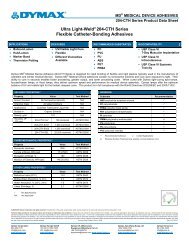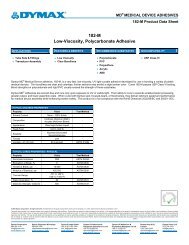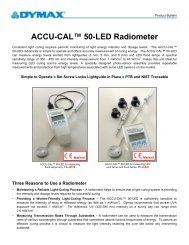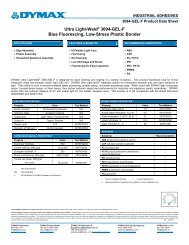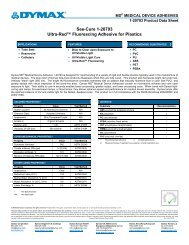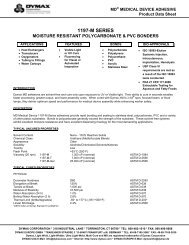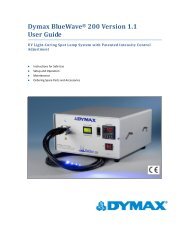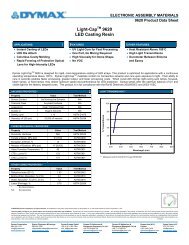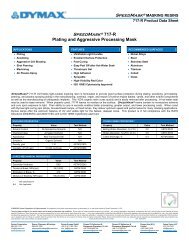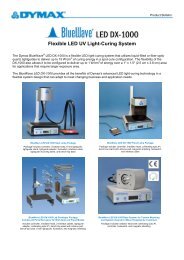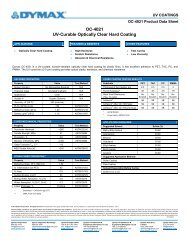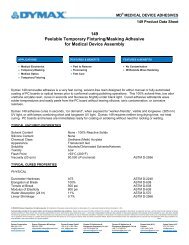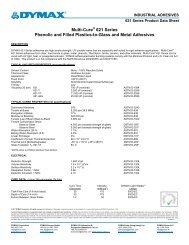Aerobic Adhesives VII – A New High Performance Bonding Option ...
Aerobic Adhesives VII – A New High Performance Bonding Option ...
Aerobic Adhesives VII – A New High Performance Bonding Option ...
Create successful ePaper yourself
Turn your PDF publications into a flip-book with our unique Google optimized e-Paper software.
Table 1. Adhesion of Various UV Resins<br />
UV <strong>Aerobic</strong> Acrylics UV <strong>Aerobic</strong><br />
Epoxies<br />
Tensile Strength Steel >3000 psi >500 psi<br />
per ASTM D1002, Glass >2000 psi >1500 psi<br />
DSTM 250, DSTM Plastic Generally exceeds >100 psi<br />
251<br />
material strength<br />
Speed Of Cure: 1 mil ~ 2 sec ~ 2 sec<br />
20 mil < 5 sec < 5 sec<br />
Surface Finish:<br />
Some may have<br />
oxygen inhibition<br />
Dry<br />
The principal advantage of AAA’s include:<br />
• Lower costs • Faster cure times • Simpler application • Environmentally safe<br />
• Long shelf life • Room temperature cures • Less material waste • <strong>High</strong>er production yields<br />
• Elimination of complex jigs and fixtures • Overall reduction in production times<br />
Table 2. Typical Applications<br />
Typical Applications for <strong>Aerobic</strong> Acrylics<br />
Glass and plastic headlamp assembly<br />
Electrical sealing and tacking<br />
Optical component assembly<br />
Microelectronic assembly<br />
Dome coatings<br />
Conformal coatings<br />
Medical Disposable Device assembly<br />
Coil terminating<br />
Tamper proofing<br />
Fingernail coating<br />
Formed-In-place gaskets<br />
Figure 1. Headlamp Lens<br />
For all of these reasons and the strength and durability of the bonds formed, AAA’s began replacing heat curing<br />
and two part epoxies, urethanes and silicones in most applications where light could reach them to effect cure .<br />
Since the early 1980’s, use and acceptance of these products has cut across the industrial spectrum to include<br />
uses in automotive motor and lighting assembly, aerospace, optical, military and industrial electronic assembly,<br />
appliance, medical disposable device assembly and electrical and architectural applications, to name a few. In<br />
addition, AAA’s are able to operate over a wide temperature range, from <strong>–</strong>60 o C to 200 o C, depending on the<br />
adhesive. Table 2 lists some typical applications for which AAA’s have been used.<br />
III <strong>Adhesives</strong> Available to the Optical Engineer<br />
Optical Engineers have relied on adhesives for many applications. In most situations it is the only reasonable<br />
method of mounting. Adhesive use is a reliable approach which is cost effective and process-controlled. Often<br />
specifications of adhesives in a design leads to production problems. These problems include but are not limited<br />
to: material handling (shelf life / proper mix ratio / pot life); long cure times often at high temperature; application<br />
(tooling / training); and environmental concerns. UV and UV/visible light curing adhesives are more conducive to<br />
production applications. With improved performance these newer AAA’s are replacing many traditional<br />
adhesives. Table 3 provides a quick comparison of typical adhesives used in the Optics Industry.



